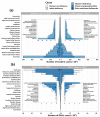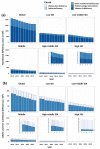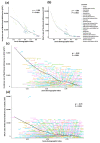Global Burden of Nutritional Deficiencies among Children under 5 Years of Age from 2010 to 2019
- PMID: 35807863
- PMCID: PMC9268233
- DOI: 10.3390/nu14132685
Global Burden of Nutritional Deficiencies among Children under 5 Years of Age from 2010 to 2019
Abstract
Under-five years of age is a critical period for children's growth and development. Nutritional deficiency during this period is associated with wasting, underweight and stunting. We aimed to conduct an epidemiological study using data derived from the GBD2019 to found the global distribution and changing trends of nutritional deficiencies among children under 5 years old, as well as the correlation between social development status and nutritional deficiencies. Nutritional deficiencies in children under 5 years has been substantially improved in the past decade; however, the progress has been unevenly distributed globally. The incidence and DALY rate decreased with the increase of socio-demographic index. In 2019, the incidence (51,872.0 per 100,000) was highest in Central Sub-Saharan Africa and the DALY rate (5597.1 per 100,000) was the highest in Western Sub-Saharan Africa. Among five subcategories of nutritional deficiencies in children under 5 years, vitamin A deficiency accounted for the largest proportion of incident cases (100,511,850, 62.1% in 2019), while the proportion of DALYs caused by protein-energy malnutrition was the highest (9,925,276, 62.0%). Nutritional deficiency in some countries remains worrisome, for whom policies guarantees and sustained efforts to control nutritional deficiencies are urgently needed.
Keywords: children; global burden; human development index; nutritional deficiencies; socio-demographic indexes.
Conflict of interest statement
The authors declare no conflict of interest.
Figures





References
-
- Kichloo A., Shaka H., El-Amir Z., Wani F., Singh J., Velazquez G.R., Edigin E., Dahiya D. In-patient outcomes of patients with diabetic ketoacidosis and concurrent protein energy malnutrition: A national database study from 2016 to 2017. Postgrad. Med. 2021;133:854–859. doi: 10.1080/00325481.2021.1916231. - DOI - PubMed
MeSH terms
Grants and funding
LinkOut - more resources
Full Text Sources
Medical
Miscellaneous

